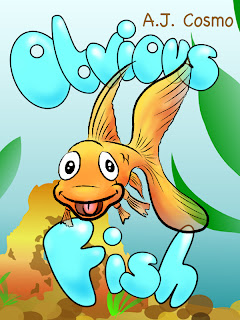Lately I've been going through my collection and examining each book on an individual basis. It's been a little over a year since I first started and I have a huge library of more than thirty titles under my belt. They range from odd stories about a
fish to a book on common
household monsters. Some of the books have done remarkably well while others have fallen to the wayside. So here's the question: when should you call a piece a failure?
About three weeks ago I pulled "The Schmoopie" from the Kindle store shelves. It felt horrible. The story was about a sad little animal that different kids try to cheer up. They of course couldn't cheer it up and so get frustrated and throw the creature out. Then one day a pair of sad children find the Schmoopie and take it home. They spend the night complaining to each other about how horrible life is and suddenly the Schmoopie doesn't feel so bad anymore. It leaves happy and goes on its merry way.
I really like this story. It's one of those lessons where you can get it without being able to articulate the meaning. I think kids pick up on these sort of lessons way better than adults. I like the lesson too. I think more people should listen to each other, really listen I mean not just wait for the chance to speak. Yet, it doesn't matter how much I like a piece. In the end I don't matter. Sure my tastes and way of being in the world define my work, but if a painting hangs in an empty museum, why display it?
That's not to say that creating unsuccessful work doesn't have any meaning, you can extract more from your failures than you can your successes, but you have to analyze the works themselves. Which brings me to this piece:
Good gosh that hair is awesome! I loved doing this book. The art style was cartooney but without the black outline, a callback to Disney's Snow White and The Seven Dwarves. I also liked the story about a man challenged by progress to defend his work. It was a metaphor for what we're all going through right now where our jobs and our lives are constantly encroached and changed by new technology.
Unfortunately, I had also accidentally written a children's version of the story "Needful Things" by Stephen King. If you're unfamiliar with that one, it's about the devil coming to s small town and opening up shop with challenges to the village residents. Ok, maybe I didn't go that far, but there are illustrations of scissors flying above a little girl's head. The book had some terrifying imagery. It also had a meaning that was completely irrelevant to most children, since technology creep is mostly experienced by adults. Oh and very few children are in to hair cutting, in fact most of the younger ones are scared of it.
People hate this book. The reviews have been terrible, worse than "The Schmoopie", and the sales have reflected this. The audience has spoken and this piece needs to go back and keep "The Black Cauldron" company. It sucks, it really does, but I do believe that having failures will enable me to make better content for my audience and thus have a better venue for communication. No, I don't believe in "selling out" or only making what you think will appeal to people, that's the surest path to failure, but the more effectively you can appeal to your audience the more effective your communication will be, And that's what this is really all about: communication.
So when can you call a piece a failure?
When it doesn't communicate.




